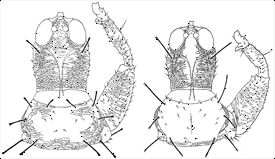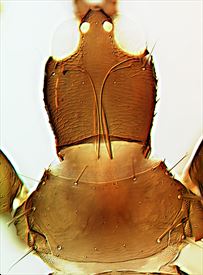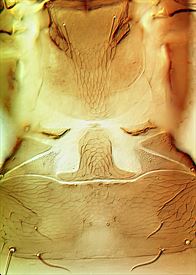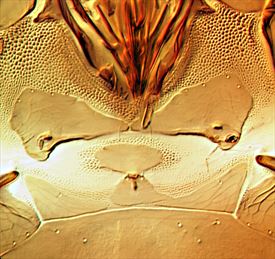Thrips of New Zealand

Antenna

Antenna

Female & male, head & pronotum

Female head & pronotum

Metanotum, pelta & tergite II

Thoracic sternites
Distinguishing features
Both sexes fully winged. Female brown; tarsi, fore tibiae, and apices of middle and hind tibiae paler; antennal segments III–VII bicoloured, with proximal half of III and IV, proximal third of V and VI, and extreme base of VII yellow; fore wings faintly shaded medially; major setae pale. Head bearing up to 6 pairs of small, stout marginal setae; maxillary stylets reaching to compound eyes; compound eyes slightly larger dorsally than ventrally; postocular setae wide apart, expanded at apex. Antennae 8-segmented; segment III excavate on inner margin, with 3 sense cones, IV with 4 sense cones. Pronotum sculptured on margins, with small, scattered discal setae; major setae expanded at apex. Prosternal basantra absent; mesopresternum divided into 2 lateral triangles. Metanotum with median area faintly reticulate; median pair of setae acute, wide apart, in anterior half of sclerite. Fore wings constricted medially, with a distinct 'pocket', and with 10–14 duplicated cilia; sub-basal setae subequal and expanded at apex. Pelta reticulate, elongate, with lateral lobes; tergite IX posteromarginal setae slightly expanded at apex and more than half as long as tube.
Male similar to female, but head with postocular setae longer, marginal setae stouter; sternite VIII with a small, circular pore plate; large males with pair of tubercles on inner apex of fore femora and a smaller tubercle on inner margin of fore tibiae; major pronotal setae longer, particularly anteroangulars, but anteromarginals small and acute.
Related species
The genus Hoplandrothrips comprises about 120 species worldwide, particularly in tropical areas, but with nine species recorded from Europe, 16 from Australia, and four from New Zealand. H. bidens is an introduced European species that is distinct from the New Zealand species-group in this genus that comprises H. choritus, H. ingenuus and H. vernus. These three species differ from bidens and most other species of Hoplandrothrips in the following character states: antennal segments dark (not bicoloured); segment III with a straight (not excavate) inner margin; mesopresternum entire (not divided); metanotum with 2 or more pairs of minor setae on anterior half of sclerite, and median major setae arising well behind these minor setae; male fore femora lacking apical tubercles; fore wing scarcely constricted medially, and lacking a median 'pocket'.
Biological data
Feeding on fungal hyphae or their breakdown products, and in New Zealand living on dead branches of trees that are not native to this country.
Distribution data
This species is widespread across Europe, and is introduced to New Zealand (AK / MB, BR, MK, CO).
Family name
PHLAEOTHRIPIDAE, PHLAEOTHRIPINAE
Species name
Hoplandrothrips bidens (Bagnall)
Original name and synonyms
Acanthothrips bidens Bagnall, 1910: 374.
Hoplandrothrips collinsi Bagnall, 1914: 37.
Phloeothrips (Hoplandrothrips) tridens Priesner, 1914: 195.
Phloeothrips bagnallianus Priesner, 1923: 101.
Phloeothrips unidens Priesner, 1923: 101.
Phloeothrips parvulus Bagnall, 1927: 584.
Phlaeothrips bidens f. simplex Priesner, 1964: 184.
References
Mound LA, Morison GD, Pitkin BR & Palmer JM (1976) Thysanoptera. Handbooks for the Identification of British Insects 1 (11): 1–79.